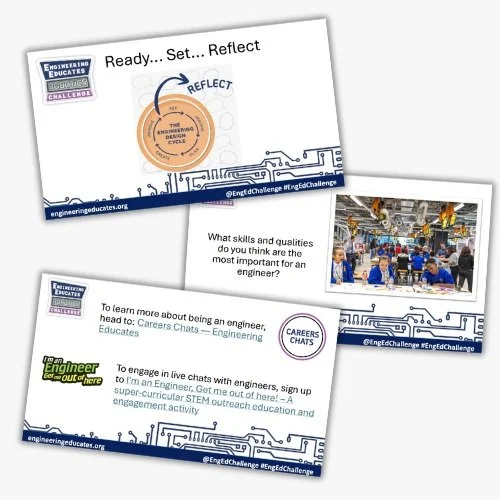
Think as an Engineer
Support your learners to think as an engineer
Engineers solve problems by asking lots of questions to understand who needs help and what solutions already exist. They work together to test and improve their ideas, making sure the final product really works. Thinking like an engineer means practicing, sharing ideas, and always finding ways to make things better. Following the steps of the Engineering Design Cycle helps build these important habits of mind.
Ready… Set… Reflect
Research has shown that follow-up reflection activities help to reinforce the learning, encourage critical thinking, support personal growth and build connections, all of which help learners to solidify knowledge and develop a deeper appreciation for the subject.
You are encouraged to facilitate a reflective discussion with learners by sharing these slides a couple of weeks after they have completed the challenge.
Which EngEd Thinking Prompt will inspire your next lesson?
Engineering Design Cycle Sort
Understanding the Engineering Design Cycle helps learners grasp how engineers think and work as part of a clear, connected process.
Design Specification Support Template
Design specifications are essential because they clearly communicate important details from the start. They guide the design, keeping it focused and consistent, and include things like dimensions, colours, materials, and key features—helping prevent misunderstandings and costly mistakes.
Mind Map Prompt Cards
This mindset is key to engineering, helping learners understand how different activities connect to form the engineering process.
Analysing products with ACCESSFM
ACCESSFM is a systematic tool to support learners in evaluating products and developing clear design specifications.
SCAMPER is a framework that helps learners overcome idea fixation by exploring new ways to adapt or improve a product. Created by author Bob Eberle, it uses prompts from his 1971 book to spark fresh thinking.
Engineering Evaluator
Evaluation is a key part of any engineering process and can lead to further questions, problem finding and improving. This template provides a stimulus for evaluation aligned to the design specification.
5Ds Decision Maker
This resource helps learners discuss and evaluate which activities pose challenges for people, making it easier to identify tasks that robots could better support.
S.C.A.M.P.E.R
Systems thinking mapping exercise
This supports learners to identify subsystems and their interdependencies, considering how missing or modified parts affect the overall system.
This video introduces learners to the 5Ds of Robotic Engineering. 5 themes that influence engineer’s decisions about whether certain activities undertaken by humans would be better supported by robots.
5Ds Introduction video
Duration 1:30 minutes


